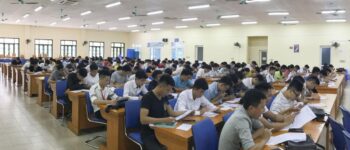Recently, the Ministry of Education and Training officially announced 18 reference topics for the 2025 high school graduation exam, including English and Chinese. According to many teachers' assessments, the change significantly in the structure and content of the exam, to meet the goal of assessing language competency according to the 2018 General Education Program.
- Cần sớm phân quyền xác nhận bằng cấp của giảng viên nước ngoài cho Bộ GDĐT
- Kỳ thi tốt nghiệp THPT từ năm 2025 có thêm môn tin học, công nghệ
- Trường Đại học Thủ Dầu Một công bố điểm trúng tuyển, dao động từ 15 – 26.47 điểm
- Không có giáo viên nghệ thuật ở THPT, học sinh vất vả, tốn kém tự tìm chỗ học
- TS Lương Xuân Chiểu: Những việc khó, thực tiễn cần là cơ hội của người NCKH
Highly differentiated English reference questions, supporting effective university admission
Bạn đang xem: Giáo viên đánh giá gì về đề tham khảo môn Tiếng Anh, Tiếng Trung?
According to the assessment of Master Ho Thi My Van, Head of the Foreign Language Department, Practical High School, Ho Chi Minh City University of Education, English reference questions for the 2025 high school graduation exam Demonstrates higher differentiation than previous years, helping to clearly distinguish students' abilities. The questions are no longer separate from grammar and vocabulary but focus on assessing applicability in real communication situations.

Illustration photo: La Tien
Ms. Van analyzed that the English reference test has a duration of 50 minutes with 40 questions, focusing on key knowledge and skills such as grammar, vocabulary and reading comprehension skills. The topic focuses on reading comprehension skills, because this is an integrated skill, allowing direct and indirect assessment of aspects of language knowledge such as vocabulary, grammar, along with receptive ability. , process and apply other skills such as speaking and writing. The texts used in the exam are all related to current and practical issues, such as technology, social networks, environmental protection and urbanization, which are issues close to candidates. and interested community.
This gives candidates the opportunity to demonstrate their language processing ability through familiar situations in life as well as media documents on popular topics, while maintaining interest in taking the test.
Ms. Van also commented in detail on some important changes in this year's reference exam compared to previous years. Specifically, the exam no longer has questions about distinguishing phonetics and stress, as well as no error-finding questions. The grammar section is integrated into the information gap exercises, with 15 questions at the awareness and comprehension level. Synonym/antonym search questions have changed to vocabulary questions based on the context of the reading comprehension text instead of individual questions. Individual questions about combining two halves of a sentence into a complete sentence are converted into text-completion (filling in the blank to complete a paragraph with phrases / “phrases”). The fill-in-the-gap reading passage is difficult, requiring candidates to apply grammatical knowledge and understand the context of the passage.
Another highlight is the appearance of new types of articles about arranging paragraphs, letters or announcements. This type of lesson requires students to have logical thinking and understand the flow of the text, not just rely on connecting words like “firstly”, “secondly” or “moreover”. At the same time, some types of questions appear for the first time in the exam, such as “paraphrases”, “best summarises”, “best fit” filling in the sentence in the appropriate paragraph.
“The exam requires students to have good reading comprehension skills, from short and easy texts to difficult and complex texts,” Ms. Van emphasized.
Ms. Van believes that students may feel “overwhelmed” when looking at an illustrated question paper with 4 pages full of text and few individual questions like before. However, this change is consistent with the trend of assessing students' language ability instead of just testing simple grammar and vocabulary knowledge.

The English reference question for the 2025 high school graduation exam has a number of new question types, such as “paraphrases”, “best summarises”, “best fit” filling in the sentence in the appropriate paragraph.
Ms. Van said that the test is designed for students who have completed the 2018 high school English program, with an English level of level 3 according to the 6-level Foreign Language Competency Framework used for Vietnam, equivalent to level B1. according to the Common European Framework of Reference for Languages (CEFR). The high differentiation in the exam not only ensures the criteria of a graduation exam but is also a useful tool for universities to use exam results in the admission process.
Xem thêm : Thí sinh chọn xét tuyển đại học bằng điểm thi tốt nghiệp có đang bị thiệt thòi?
Sharing the same opinion, Ms. La Thi Thu Thuy, English subject leader, Ngoc Hoi High School (Thanh Tri) assessed and referenced English in accordance with the output goals of the 2018 general education program. , especially focusing on reading comprehension skills and language use in real-life situations. The test ensures that students can use English at a basic communication level and understand common topics in life.
According to Ms. Thuy, the 2025 English reference exam still retains familiar parts such as reading comprehension, grammar, vocabulary and word filling, but some parts have been simplified. Compared to previous exams, this year's reference exam has had clear adjustments such as the removal of idioms, pronunciation, and individual grammar and vocabulary questions. Instead, there are exercises to fill in words, fill in clauses, and arrange conversations. This change helps students focus more on developing reading comprehension skills and grammar knowledge, to assess students' general ability to use English instead of testing too much specific knowledge.
Ms. Thuy believes that the difficulty of this year's reference questions is not much different from the official questions of previous years. However, new lesson types require students to learn English more comprehensively, not only focusing on grammar and vocabulary but also practicing reading comprehension skills through diverse English texts.
References: Vivid Chinese, rich vocabulary
Commenting on the reference topic in Chinese, Master Bui Thi Lan, Chinese teacher, High School for Foreign Languages, University of Foreign Languages, Hanoi National University, said the reference topic is 40. 50 minutes of questions is appropriate.
The exam covers knowledge from grades 10, 11, and 12, ensuring students are fully prepared. The proportion of questions is reasonably distributed, with nearly half being questions at the awareness level, the rest divided equally between the comprehension and application levels.
Ms. Lan commented that this year's reference questions are “more comfortable” than the official questions in previous years. She believes that the lively test format, with short, clear texts, and rich but not too long text (many texts are only about 150 words), will help students feel comfortable and interested. than when doing homework. Questions based on real-life contexts, short and easy to understand help students have a basis for choosing more accurate answers.
“In terms of content, the texts all belong to high school topics. Some corpus texts have quite new forms, but are very close to students. Specifically, these are conversations about plans, about exchanging information in life, a letter to teachers, or a power cut notice from the Department of Electricity,” Ms. Lan said.
According to Ms. Lan, the reference focuses on assessing reading comprehension skills through oral forms (sentences 1-2) and written language (sentences 33-37), which helps reflect students' communication abilities. in a more comprehensive way.


The Chinese subject reference focuses on assessing reading comprehension skills through oral forms (sentences 1-2) and written language (sentences 33-37).
Ms. Lan said that the output goals of the 2018 general education program address all four skills of listening, speaking, reading, writing and language knowledge. However, in the reference question, the main skill assessed is reading comprehension. Some questions are related to speaking skills (questions 1-2) and writing skills (questions 22-24), but are still basically based on students' reading comprehension ability.
Regarding language knowledge, questions at the recognition and comprehension levels are included in the program, however some questions at the application level require students to make inferences from the text context (for example, verses 25, 28). Although these questions are not represented in the new curriculum, they will not cause difficulties for students studying the old textbooks, as the content is still taught in them.
Xem thêm : Hành trình trở thành nhà giáo, nhà nghiên cứu của Phó Giáo sư Nguyễn Vũ Quỳnh
Compared to previous Chinese exams, the structure of the 2025 reference exam has changed significantly. All questions in the test are no longer single sentences but are integrated into conversations (such as sentences 1-3), paragraphs (sentences 12-21), or specific applied texts (sentences 4- 11, 33-37). Ms. Lan believes that this change is reasonable, helping students access language in real communication situations, instead of just focusing on theoretical grammar knowledge. This change is consistent with the trend of testing language ability rather than just assessing language knowledge, requiring foreign language teaching to be practically effective.
In addition, the exam no longer contains questions about word order like the previous ones, but instead there are questions about the order of ideas/sentences in a paragraph. This does not affect the testing objectives, but still ensures practical application.
Another difference is that this year's reference question does not have questions about phonetics and Chinese characters. Ms. Lan commented that phonetics in the new program mainly focuses on intonation and expression, so compiling test questions for this section is difficult. However, she believes that there should be more questions related to Chinese characters because this is a characteristic of the Chinese subject.
Overall, Ms. Lan commented that the reference questions both meet the testing and assessment requirements according to the 2018 General Education Program and do not cause disturbance or confusion for teachers and students. In addition, the exam has reduced the burden of single knowledge testing questions, focusing instead on using language in real-life contexts.
Tell candidates how to review effectively
To prepare well for English in the 2025 high school graduation exam, Master Ho Thi My Van advises students to firmly grasp grammatical knowledge and vocabulary in textbooks, and at the same time practice skills. Read and understand new types of topics. Students should practice reasoning skills, guess meaning, and allocate time appropriately when doing homework. Ms. Van also emphasized the importance of building information according to standard text logic, analyzing semantics and information structure in announcement, advertising, email, and academic documents.
Finally, Ms. Van suggested that students should refer to reading comprehension exercises such as TOEFL iBT Reading to improve their skills. A reasonable study plan and time allocation, balanced with other subjects, will help students achieve the highest results in the exam.

Ms. La Thi Thu Thuy advises students not to ignore practicing listening, speaking and writing skills, which helps improve communication skills and apply them to conversation and text arrangements.
Regarding Chinese, Master Bui Thi Lan reminded students about to take the graduation exam: “First of all, you need to focus on reviewing according to the books and materials provided or recommended by teachers.” for your reference. No matter how much you study, you will definitely get there by practicing. Absolutely do not study poorly or study incorrectly. Besides, students can learn and review Chinese anywhere, anytime.
In daily life, children have many opportunities to come into contact with Chinese, which can be everyday items such as stationery, clothes, appliances, household appliances, or medicine boxes. y. In their free time, they can follow some trusted TV channels, YouTube or tiktok that use Chinese.
They should also take advantage of opportunities to boldly communicate in Chinese with teachers, friends, or Chinese people they meet. These are real-life contexts that help students form Chinese thinking, contributing to improving their language ability to do well in Chinese exams.”
Chau Anh
https://giaoduc.net.vn/giao-vien-danh-gia-gi-ve-de-tham-khao-mon-tieng-anh-tieng-trung-post246502.gd
Nguồn: https://truonglehongphong.edu.vn
Danh mục: Giáo Dục









